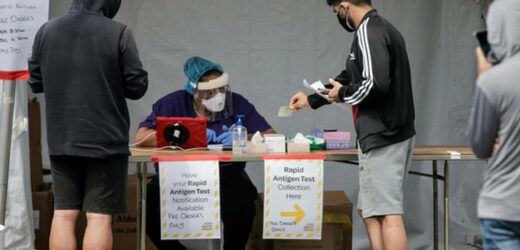New Zealand has experienced its deadliest week of the pandemic with more than 100 Kiwis dying, yet epidemiologists are backing the possibility of a change in Auckland’s Covid settings.
Cabinet meets tomorrow to consider whether it will move the country – or select regions, such as Auckland – from the red traffic light setting to orange, a change that would mean there are no longer limits on how many people can gather indoors.
It comes as 23 Kiwis with Covid died yesterday and 104 have died since Monday.
Yet while deaths are rising, Covid case numbers and the pressure on the health system has been easing.
The Ministry of Health yesterday reported 11,560 new community cases, well down on earlier daily figures that soared above 20,000.
There were also 678 people with Covid in hospital yesterday, down from a peak of 1016 on March 22.
Numbers are falling fastest in Auckland, with the city now about four weeks past its Omicron outbreak peak, epidemiologist Professor Michael Baker says.
In fact, Auckland case numbers could have already fallen close to what might be a baseline number of daily infections going forward of about 2000 cases a day, he says.
“That means there is an important discussion to have about what set of controls are we moving towards for the rest of the outbreak,” Baker says.
However, Baker questions whether the orange light setting is the right setting.
Under red, indoor events are restricted to a 200-person limit, with everyone seated and separated, and wearing masks unless eating or drinking.
At orange, there are no limits on indoor gatherings, no requirements to be seated or separated, and masks are still required, but can be taken off to eat and drink.
Vaccine passes will also no longer be used, meaning the vaccinated and the unvaccinated are freer to mix.
Covid-19 Minister Chris Hipkins earlier said the main thing the Government was looking for when deciding to move regions to orange was an indication of where the country was “in terms of the overall peak”.
Covid-19 modeller Professor Michael Plank says that as of last Friday, only about 367 of Auckland’s 2700-odd hospital beds were taken by Covid patients.
“If the trends we’re seeing continue in Auckland, I think a move to orange would be reasonable,” Plank says.
However, it could lead to an increase in cases again.
“If you’re indoors, the ventilation is poor, unmasked people are drinking, and there’s unlimited numbers, there’s potential for an uptick in infections across Auckland,” Plank says.
In Auckland there are still 352,752 people eligible for a booster vaccine who haven’t had it with three doses being more effective against serious illness from Omicron than two.
Nearly a quarter of children aged 5-11 – 40,000 out of 168,000 – are also yet to have any vaccine dose; 77 per cent have had one dose and 18 per cent have had two.
However, the city has also had Omicron sweep through it, with up to a third of Aucklanders catching it – and thereby having a low chance of recatching it within three months.
This is the main reason why Plank believes a move to orange in Auckland can be justified.
“I wouldn’t have thought that [a move to orange], on its own, would be enough to reverse the declining trends we’re seeing at the moment.”
He believes a greater focus should be placed on sustainable measures – such as improved ventilation, and generous leave provisions to encourage sick people to stay home if sick – “as we come to the end of the sprint with Omicron and move into the marathon”.
But Baker is more cautious, saying he is not sure a move to orange is based on any real evidence.
He says health officials now have little empirical evidence about where Covid infections are occurring.
Are they occurring at home and how many are taking place at schools, for instance, he says.
“Where are those roughly 2000 daily cases in Auckland coming from, where are people getting infected and what can we do to reduce the number is potentially a more important question than moving from red to orange.”
Instead of changing traffic light colours, the Government has been changing the rules of each traffic light setting, Baker says.
“I’m not sure what difference it will make because the difference between the red and orange settings has been blunted.”
With Australia’s eastern states now experiencing a second wave of Covid that meant there was cause to pause, collect more empirical data and review what tools should be used in New Zealand in the future, he says.
While Auckland is about four weeks past its peak, Baker warns the South Island may only be just passing its peak infection numbers.
It comes as there has now been 378 publicly reported deaths of people with Covid-19 in New Zealand since the pandemic began, most of them since the Omicron variant outbreak began in January.
Source: Read Full Article

/cloudfront-ap-southeast-2.images.arcpublishing.com/nzme/YQWQJVBWFR4YZCCXQLTXET4R3U.jpg)
/cloudfront-ap-southeast-2.images.arcpublishing.com/nzme/MX2EDWTBTN7OZSVAVO2PLFPBLI.jpg)
